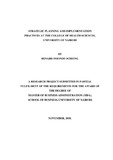| dc.description.abstract | Managers of many organizations including the College of Health Sciences (CHS) are often hesitant in planning and implementation of new strategic plans. Most organizations are comfortable with their status quo and are not keen to re-engineer new strategic plans that would lead to unknown new positions in the dynamic environment. The higher education industry has undergone tremendous changes from the twentieth century to-date thus the industry has become competitive and the University of Nairobi (UoN) can no longer assume to be the University of Choice. Public and private universities in Kenya and abroad are now offering the same courses or even better courses that were the preserve of the UoN; this has created discomfort within the UoN and the constituent colleges.
The CHS being a constituent college of the UoN has therefore formulated strategic management plans that will endeavour it to thwart competition from other universities or colleges within the higher education industry by adapting to the changes in the environment. Strategic planning relates to the positioning of the organization in the industry and relating the organization to its environment in a way that will assure continued success thereby achieving a competitive edge over other competitors. The study sought to understand the practice of strategic planning and implementation at the College of Health Sciences (CHS) and the challenges encountered during the process of planning and implementation. The principle of the study was to find out if the institution responds to the environmental changes since the environment is dynamic. The research project was a case study of the CHS whose objective was to establish strategic planning and implementation practices at CHS.
In order to answer the questions that were asked, primary and secondary data was collected. The primary data was obtained through a one on one interview while the secondary data was obtained through VoN academic calendars, CHS strategic plan document and various other departmental documents. The data was collected and analyzed by use of content analysis. The study established that CHS uses a corporate strategic plan and that its objectives are aligned to the vision, mission statements. The cascaded corporate strategic plans were not totally inclusive when it comes to employee and students involvement.
Sensitization of employees and students towards the implementation of the strategic plan was not frequent and so was the frequency of scanning the environment. The absence of a monitoring and implementation team further made it difficult to attain a systematic implementation plan as per the action matrix in the CHS strategic plan blue print. The research further established that the CHS encountered challenges such as; lack of financial resources, disconnect between plans and implementation, resistance to change, inadequate staffing in some areas, bureaucracy, and continuous increase in the number of students being admitted to the college during the strategic planning and implementation at the CHS. It was also established these challenges at the CHS would be reduced if more employees are involved during the planning and implementation stages. | en_US |

